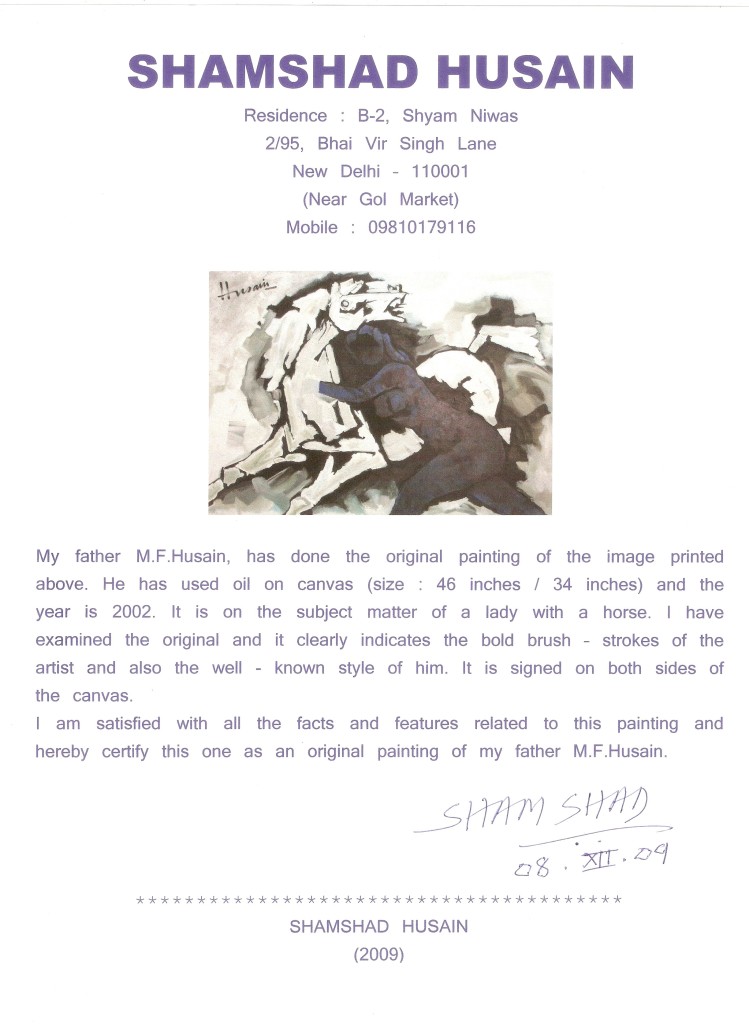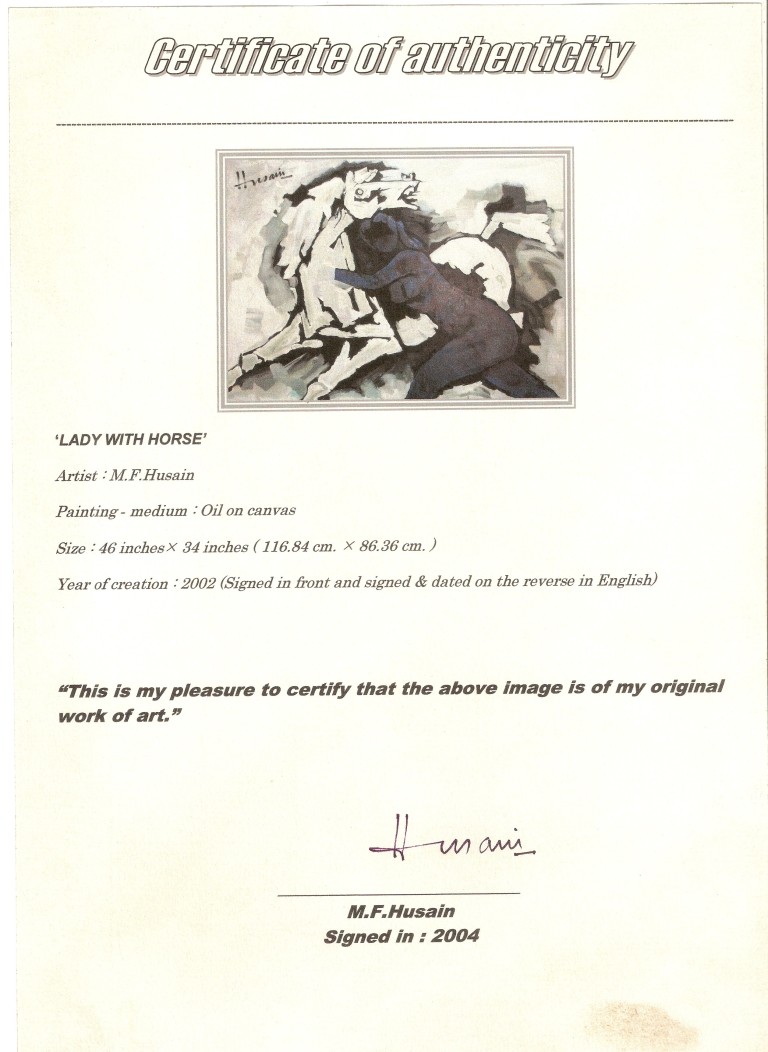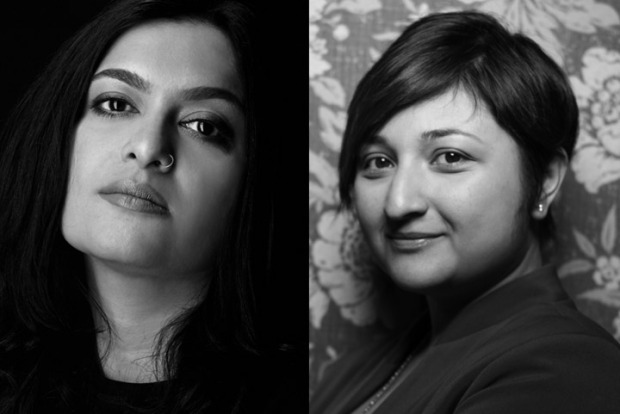Recent developments in the Indian art market – the withdrawal of key works by important artists from auctions conducted by leading auction houses – point to the enormous threat being posed to a healthy art market by an unchecked and brazen parallel market for art forgeries, or ‘fakes.’ While auctions may be the most public undressing, fakes can be seen everywhere: in galleries, with art dealers and at well-known collectors’ homes, for example. Images of fakes are carried in reputed art magazines with editorial persons absolving themselves of responsibility vis-a-vis advertisements. Questionable works crop up regularly in publications and auction catalogues, validating the existence of forgeries as legitimate works of art. Well-known galleries and auction houses plead ignorance in instances of discovery. Significant legal recourse is currently not available, thereby placing the onus on individuals for greater transparency and oversight.
Politics of Art walked in unannounced to a few galleries that deal with works of the Moderns in Colaba, Mumbai. What we uncovered was shocking: fakes of major artists such as M.F. Husain, Manjit Bawa and F.N. Souza, among others, line the walls of these galleries, with art dealers openly touting poor quality fakes as originals. It’s hard to accept that such criminal activity happens openly, and without fear of legal repercussions.
In light of recent events, Politics of Art posed a questionnaire to 5 prominent personalities –a representative of a well-known auction house, an Independent authority on a major Modern artist, a family member of another major Modern artist, a leading gallery owner, and an author of a fictional book on the fake art market. We extracted the most salient points from their commentaries that shed light on the dubious fake market.
What came up is an open secret
- The fake art market is large enough to ring alarm bells. The stakes have risen sharply in recent years with the expansion and growth (not to mention, soaring prices) of the Indian art market.
- The artists being faked the most are Modern Indian artists: M.F. Husain, S.H. Raza, Manjit Bawa, F.N. Souza. Bengal School artists: Somnath Hore, Jamini Roy, Ramkinker Baij, Bikash Bhattacharyya, Rabindranath Tagore.
- Several influential players within the Indian Art Market are culpable: from reputed galleries and auction houses, from family members of deceased artists to critics who “authenticate,” the nexus of deceit is widespread and well entrenched.
- Canny collectors and greedy buyers in cahoots with rogue dealers are part of the web.
Our blog post provides our own case study, comments from reputed names on different aspects of the faking business, links to other related posts. We welcome critical feedback and responses as well as information that would be of use to the art community and for buyers in our comments section.
ART WORLD EXPERTS ON FAKES
QUESTIONS
• How large would you estimate the Indian market for fakes to be? Which are the artists being faked the most? • Would you it be correct to say that galleries, auction houses and buyers are part of the nexus too? Can you cite some incidents of such discoveries and action taken thereafter? • Are there any legal precedents or avenues of re-dressal available at the moment? • On discovery, does it become the artist’s estate/family’s responsibility to take action against the gallery/forgers? • Caveats to buyers?
RESPONSES
1. DADIBA PUNDOLE, PARTNER, PUNDOLE’S AUCTION HOUSE, MUMBAI “The usual suspects are generally independent dealers or consultants who don’t exhibit but rather deal with clients on a one-to-one. However much galleries may despise auction houses, it is in the auction situation that brings to light most fakes. The public visibility invariably provokes a debate on the authenticity of a work and leads to withdrawal.
Even though punishable by law, it is almost impossible to take any action against organized faking. The police are reluctant to register a complaint – this is the first step. They can’t be blamed entirely either as they lack the necessary expertise. As long as buyers keep looking for ‘good deals’, they will always be susceptible to fraud. I would equate your art dealer to your doctor who you trust. And similar to a doctor, he cannot be a specialist in all aspects of art.
It would be appropriate for an artists’ estate, if there is one, to take necessary action. The first step would be to issue a legal notice to the offender and if the painting reappears, take necessary legal action. All the above sounds good in theory but within our current legal system it is impractical for an individual or family to devote the time. A young lawyer who might be interested and has the inclination should be identified along with a sympathetic police officer. Once the process starts it will gradually become a lot easier to take action and could even become a lucrative profession.”
2. INA PURI, DOCUMENTARIAN, CURATOR & AUTHORITY ON MANJIT BAWA, NEW DELHI “More often than not, when auction houses like Christie’s, Sotheby’s and Bonham’s approach me to look at works purportedly by Manjit Bawa, if the work is not Bawa’s then it is withdrawn from consideration. In the year 2000, Manjit and I discovered a miniature in the Christie’s New York auctions, which turned out to be a fake. This was later withdrawn when we raised an objection.
We did seek legal advice on copyright laws in 2004-5, but before any course of action could be decided upon, Manjit went into a coma. For artists to catalogue their own work is therefore of crucial importance. Manjit and I had started a book project similar to a catalogue raisonné, but unfortunately this was never realized before his illness took over.
At present the problem (of fakes) is dire, as there are only a few living experts to authenticate works. There are also questionable practices of conservation (which sometimes includes signature restoration) of which buyers should be aware, when appraising the provenance of a “signed” work.”
3. YUSUF MEHTA, SON OF TYEB MEHTA “While there is no legal onus on the artist’s family, we do feel that there is a moral responsibility to bring a fake to the attention of the buyer and seller of the work. The Tyeb Mehta Foundation set up by the family regularly receives at least two to three requests for authentication of Tyeb Mehta’s works. Only a miniscule number of the works sent to us for verification are authentic.
I would presume that there are a large number of works claiming to be his, of which we are not even aware. This would make the number of fake works available for sale today many times more than the value of his authentic works that are available. We are lucky that my father documented most of his work. We have access to high-resolution images that provide us with a means of comparison – in that we do not rely on memory alone.”
4. SHIREEN GANDHY, DIRECTOR, CHEMOULD PRESCOTT ROAD, MUMBAI “Faking happens in the case of living artists too. I was party to such an incident when I bought a work by Anjolie Ela Menon from a regular dealer, someone I trusted and continue to trust. Neither he nor I were aware that Anjolie Ela Menon, an artist in her prime, was being faked. Apparently her ex-assistant was involved. The dealer friend brought it to me, and in turn, I sold it to a client looking for a work by the artist. After the client got the work, she took it to Menon to show her the new acquisition, unsuspecting of any fraud.
It was fortunate this happened. Anjolie found the work to be a fake and immediately contacted the police and registered a complaint against her assistant (whom she suspected of carrying out the deed). The dealer and I returned the money to the client and gave our complete compliance in assisting Menon with the case. The action worked because it put an immediate stop to that assistant indulging in any further activities.”
5. AMRITA CHOWDHURY, COUNTRY HEAD & PUBLISHER, HARLEQUIN INDIA & AUTHOR OF ART CRIME THRILLER FAKING IT “Borrowing from the world of business, Harvard Business School professor Tarun Khanna defines institutional voids as gaps in an emerging marketplace, which lead to opportunities for business (or exploitation, as the case may be). Despite the rapid growth in demand for Indian Art over the past two decades, with accompanying hoopla over acquisitions and pricing indices, it remains an imperfect marketplace.
The infrastructure needed to support the art industry, such as valuation expertise, paper trails, critical appraisals and writing, restoration expertise, still need development. Provenance papers are largely missing in India. Many originals were in collections of old estates, where such records were never created or maintained. It is but natural that the first movers to exploit the opportunity were the forgers.
When buying a trophy piece, buyers should not take for granted the reputation of the gallerist, owner or auction house. They should do their own research about the artist and the piece, request for papers where available, get the feedback from independent experts, speak to the family of the artist where possible, and generally avoid rash, impulsive decisions. Even if a piece is being sold at an auction- whether live or online, the works will be available for preview. Buyers could always take an independent expert for a casual preview. At least, the first cut visual appraisal should be done.”
POLITICS OF ART CASE STUDY
A few years ago, we were working to sell a painting by M.F.Husain that had come to us from another dealer, who was apparently connected to the seller in New Delhi. The image of the work and two pieces of supporting documentation were provided, and upon inspection, other than some minor condition issues, the work appeared to be genuine. It was a good size, and appeared to be of solid provenance. Allegedly, the current seller had bought the work directly from Husain in 2002, the year he painted it, and had had it authenticated by the artist in 2004. So it was signed on the front top left hand and also on the verso with the date. The work bore Husain’s signature strong lines and impasto brushwork in the white areas.
Red flag However, there were a few red flags, which compelled us to investigate further. Firstly, the price was too good to be true. The asking price was 60 lakhs (about US$130,000 at the then exchange rate), which for a work by M.F.Husain of this quality and provenance – it had also been published in the book Husain 88 – was a steal. Secondly, the sellers were putting an enormous amount of pressure for a quick sale. In most cases of authenticity of premium quality works, there’s no such thing as a steal. These works almost always come at a premium. Clearly, the unscrupulous sellers were looking to flog the work as quickly as possible. Thirdly, the work when it was shown to us was unrolled and spread across the floor. Would you stick a painting worth US$130,000 in a roll, courier it to another city and allow it to be handled so casually? Something didn’t fit.
Too good to be true We made an appointment with a leading expert on M.F.Husain’s work and took the work to him. What we uncovered was unbelievable. The same painting published in Husain 88 had been auctioned by a major auction house a few years after the date of the alleged purchase by the buyer, setting up the first major contradiction in provenance. So, could there have been a copy made by the artist? According to the expert, “no”! While he admitted that the copy displayed a certain virtuosity of paint handling that resembled the artist’s strokes, there were further contradictions in the materials and techniques used that pointed towards a potential forgery. Why would the artist so painstakingly copy himself? Remember, a faker never employs a structure to build a painting. It is only the surface that they replicate.
We walked away from the deal, but the whereabouts of this painting are unknown. We had the advantage of having access to a living expert, but in the instance of no living experts or family members, what is to become of the parallel fake market if it is already so brazen?
Footnotes: 1. Since this case, like most cases, was never reported we have decided to keep all parties anonymous. 2. Politics of Art editors Sharmistha Ray (an Independent art consultant when the incident occurred in 2010) and Anupa Mehta worked on this deal together. 3. The documentation included 1) Husain’s authentication for the artwork signed by him, and 2) Authentication from Husain’s son, Shamshad Husain. There is reasonable doubt that both documents are forged.



